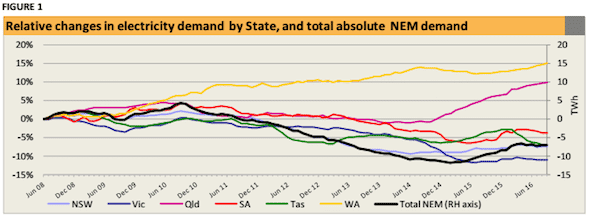Total demand in the NEM was flat on average over the year to September 2016; however, strong growth continued in WA. Total emissions from electricity generation in the NEM increased slightly in the year to September 2016, reaching a level 4.8 per cent higher than in the year to June 2014.
Total coal generation also rose slightly to 75.9 per cent, compared with a minimum of 72.3 per cent in the year to July 2014. Gas generation fell again, as it has now been doing for almost two years. Both hydro and wind generation increased, so that total renewable generation reached 14.0%. Total annual wind generation reached its highest ever level, in both absolute terms and as a share of total NEM generation.

Demand
In September, total annual demand for electricity was virtually unchanged in NSW, Victoria and SA. There was a continued fall in Tasmania as the supply cut-backs of last summer work through the annual total. Demand increased again in Queensland, with the overall outcome for the whole NEM being a very small increase.
There has now been no effective change in annual NEM demand for the six months since March. By contrast, demand in the WA South West Interconnected System (SWIS) increased quite strongly in the year to September (Figure 1).
It is not immediately obvious why demand for electricity continues to grow so strongly in WA. Faster population growth is certainly not the immediate cause. The most recent ABS demographic statistics show that the WA population grew by 1.15 per cent between March 2015 and March 2016. This was below the national growth of 1.38 per cent, and much below the growth of 1.94 per cent in Victoria (interestingly, the only state to grow at a rate above the national total).
Generation and emissions
Total annual NEM generation and emissions both increased slightly from August to September, in line with total annual demand (Figure 2). The coal share of total generation increased slightly, and consequently, emissions also increased slightly (Figure 3). For the first time in over a year, brown coal generation increased, though only slightly.
Black coal generation also increased by a small amount. Black coal generators supplied 53.6% of total supply and brown coal generators supplied 22.3%, making a total coal share of 75.9%. Gas generation fell again, as it has now done for twenty two successive months, reaching a level of 10.1% of total NEM generation.

Both hydro and wind generation also increased in September, bringing total renewable generation for the year to 26TWh, equal to 14 per cent of total NEM generation, the highest level since August 2014.
For the fourth successive month, total annual wind generation set a new record; in the year ending September it reached 10.8TWh, equal to 5.8 per cent of total generation in the NEM. For comparison, the hydro share was 7.8 per cent.
Part of this steady increase in wind generation is attributable to the commissioning of the first turbines at two new windfarms, Ararat in Victoria and Hornsdale in SA. Both are contracted by the ACT government to contribute to its 100 per cent renewable contracted electricity supply by 2020. These two projects ended a gap of 16 months with no new windfarms, since the first machines at Bald Hills, in Victoria, were commissioned in February 2015.
The halt in windfarm development was the consequence of considerable policy uncertainty regarding the RET under the Abbot government. While uncertainty was ended with the passage of legislation for a lower target, it is notable that the lower RET is still to deliver any new wind capacity. The ACT-linked wind farms are all additional to the RET – the potential certificates from ACT contracted windfarms are surrendered – and therefore add to the emissions abatement achieved through the national RET policy.

In the wake of the SA blackout, it may be useful to present some figures on generation in the four mainland NEM states, which constitute the synchronously connected NEM grid. (Tasmania is connected by a DC link, and so is not always synchronised.)
One of the responsibilities of AEMO, as grid operator, is to maintain the supply frequency within a narrow band around 50 cycles per second across the entire grid, stretching from Cairns in far north
Queensland to Port Lincoln in the west of SA. During the past year, the maximum 30 minute trading interval demand across the whole mainland NEM in summer was 31.6 GW on 13 January and in winter 30.4 GW on 27 June.
AEMO’s 2016 Statement of Opportunities records that total capacity installed in the mainland NEM is currently 44.4GW, of which 40.8GW was dispatchable (coal, gas, hydro) and 3.6 GW (8%) non-dispatchable (wind and a little large solar). Of the total dispatchable, 5.7GW (13 per cent) is hydro, mainly in NSW and Victoria, and 6.2GW (14 per cent) is Open cycle Gas Turbine, mainly in Queensland and SA.
Both of these generation types are designed to respond quickly to changing levels of demand. Prima facie, the mainland NEM at present has adequate capacity of all generation types to meet demand at all times, and this is the broad conclusion of the Statement of Opportunities.
Hugh Saddler is an energy analyst with Pitt & Sherry and this report is assisted by The Australia Institute.







